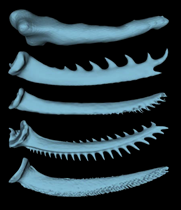|
written by: Megan Ma and Eric Hartel Scientists can propose how and why species evolve by studying the shapes of anatomical structures across animals. They can investigate what morphologies may correlate with specific functions and how the interplay between an organism’s environment and its morphology can facilitate diversification. In a well-known example, Charles Darwin observed many species of finches with varying beak shapes and sizes. A correlation was found between beak morphology and diet type: insectivorous finches had long, sharp beaks to probe and capture prey, while seed-eating finches had stronger, shorter beaks to crack open seed casings. With modern tools, continued research on these finches reveals greater information on their evolution, such as how beak shape is also correlated with altered vocalizations. It has also helped explain how different species with different beak morphologies coexist in the same habitat1. These beaks are an example of how shapes evolve to accommodate the survival and fitness of an organism, and this study system is an example of how the incorporation of modern techniques allows for the comprehensive study of shape evolution.  Photo of Dr. Cori Black. Photo of Dr. Cori Black. Dr. Cori Black (she/they), a postdoctoral fellow at the Smithsonian National Museum of Natural History, takes shape-based evolution to the next level, in which they visualize and compare three-dimensional shapes using computed tomography (CT) scans and use evolutionary tree-based thinking to investigate how jaws have evolved in different groups of fishes. Dr. Black’s work uses geometric morphometrics, a tool to quantify biological shape2. Much like how a motion capture suit uses dots to capture a person’s movements, geometric morphometrics uses landmarks i.e., specific bodily points, to capture shapes of anatomical structures. Dr. Black uses this technique to study suckermouth armored catfish3 – these catfish are the largest family of catfish in the world. They have a wide array of physical shapes in both mouthparts and spines, making them an ideal family to examine with geometric morphometrics. In combination with open-source data from MorphoSource, an online repository of over 75,000 publicly available CT scans of organisms, and 3DSlicer, an open-source program that allows users to isolate specific regions of interest for further analysis, Dr. Black was able to examine shape and relatedness in this catfish family. They could visualize jaw and spine shape and determine how different parts of the jaw are oriented relative to each other. They found that catfish jaws are extremely diverse and noted the diversity of mouth shapes that vary with diet. While the specialization of catfish for their diet seems evident, does catfish mouth shape correlate to their diet? Dr. Black also investigated the shape of catfish fin spines across venomous & and non-venomous families. Are certain spine shapes correlated with venom presence in these families?  A few examples of the wide diversity of shapes found in catfish fin spines. These spines can have different functions depending on their venomous nature and how they are utilized for defense. Photo credit: Cori Black. A few examples of the wide diversity of shapes found in catfish fin spines. These spines can have different functions depending on their venomous nature and how they are utilized for defense. Photo credit: Cori Black. The answer to both questions is no. While these experiments have not found a statistically significant correlation between shape and function, this is not indicative of an unsuccessful study. The results can help to narrow down factors that contribute to the evolution and functionality of these structures. In this situation, not having a significant correlation is useful in ruling out diet as the driving factor for jaw shape diversification and spine shape as the driving factor for venom presence. Dr. Black is now interested in determining if jaw and spine shape are correlated with behavior, ecology, species interactions, climate, modularity, or biomechanical constraints. Dr. Black credits the importance of open-source tools for making research more accessible and has shown that the skills they’ve gained through studying fishes can be transferred to other organisms like spiders. They are currently researching the evolution and functional morphology of spider mouthparts. To find out more about Dr. Black’s work, check out their website. References
(1) Podos, J; Nowiki, S. (2004). "Beaks, Adaptation, and Vocal Evolution in Darwin's Finches". BioScience. 54 (6): 501–510. doi:10.1641/0006-3568(2004)054[0501:baavei]2.0.co;2. (2) Webster, M. (2001). “A Practical Introduction to Landmark Based Geometric Morphometrics”. The Paleontological Society Papers. 16: 163-188. (3) Black, C. R. & Armbruster, J. W. (2022). “Chew on this: Oral jaw shape is not correlated with diet type in loricariid catfishes”. PLOS ONE, 17(11), e0277102. https://doi.org/10.1371/journal.pone.0277102 About the writers: Megan (Rho) Ma (they/them) is a co-advised second-year PhD student working in the Shultz Lab at UMD and the Wood Lab at Smithsonian NMNH. Their research focuses on the evolution and functional morphology of spider chelicerae (“jaws”). Eric Hartel (he/him) is a Master’s student working in the VanEnglesdorp Lab and currently serves as president of the UMD Entomological Student Organization (ESO). His work assesses the stressors that impact honey bee colony health. Comments are closed.
|
Categories
All
Archives
June 2024
|
Department of Entomology
University of Maryland
4112 Plant Sciences Building
College Park, MD 20742-4454
USA
Telephone: 301.405.3911
Fax: 301.314.9290
University of Maryland
4112 Plant Sciences Building
College Park, MD 20742-4454
USA
Telephone: 301.405.3911
Fax: 301.314.9290


 RSS Feed
RSS Feed




